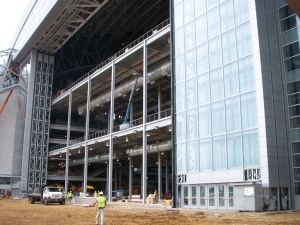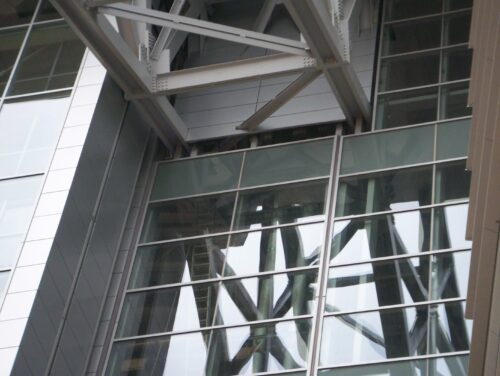 You would figure that the biggest football stadium ever built with the longest single-span arches and the largest retractable roof would have to be in Texas, and you are right. This week I got to visit the new Cowboys stadium, located in Arlington right next to the existing Rangers baseball field and tour the IT infrastructure that is supporting its operations. It was a fascinating afternoon, to say the least.
You would figure that the biggest football stadium ever built with the longest single-span arches and the largest retractable roof would have to be in Texas, and you are right. This week I got to visit the new Cowboys stadium, located in Arlington right next to the existing Rangers baseball field and tour the IT infrastructure that is supporting its operations. It was a fascinating afternoon, to say the least.
The stadium, which was designed by HKS Architects, is supported by twin steel arches that span 1,225 feet, which is twice the height of the Gateway Arch here in St. Louis. While the place is still very much a work in progress, as you can see from this picture (and they wouldn’t let us take any inside the dome itself), it is a beautiful building that is impressive when you are both inside and out. In addition to the retractable roof, there are also gigantic end-zone doors that also retract so the stadium has lots of light and fresh air — at least on the days when the weather cooperates.
 Inside the stadium is also the largest IP TV installation: there are 2,800 LCD TVs that are used for signage, menu boards for the snack and concession stands, and advertisements. Think about this for a moment: you have the ability to sell spots on all these locations over the course of the several hours that people are attending an event, and the spots can be static images, text or video. It is a sponsorship bonanza, and this alone will change the way that ads are delivered to live events in the future. I believe the new Yankee Stadium has a similar setup, although not as many TVs (of course).
Inside the stadium is also the largest IP TV installation: there are 2,800 LCD TVs that are used for signage, menu boards for the snack and concession stands, and advertisements. Think about this for a moment: you have the ability to sell spots on all these locations over the course of the several hours that people are attending an event, and the spots can be static images, text or video. It is a sponsorship bonanza, and this alone will change the way that ads are delivered to live events in the future. I believe the new Yankee Stadium has a similar setup, although not as many TVs (of course).
The biggest item inside the stadium is a center-hung video scoreboard that has 30 million LED individual lights covering four different “screens” — two are facing the end zones and are 53×30 feet and two facing the sides of the stadium are 160×72 feet. Think about these dimensions for a moment: that is bigger than the lot size of a typical suburban quarter-acre. The side-facing screens stretch between the 20 yard lines, if you can try to visualize how big that is. When we were there, they had just turned on the video signal and were showing a variety of images and let me tell you, even from the field level the display was crisp and clear and, well, just BIG. All of the TVs by the way are capable of showing full HD images. There are also video ribbons that are similar to what you find inside other stadiums that run the entire length in between the seating decks and these can be programmed to display all sorts of things.
 With all this video everywhere, ironically one of the biggest challenges was figuring out where to put the countdown clocks in the end zones where they could be seen by the players.
With all this video everywhere, ironically one of the biggest challenges was figuring out where to put the countdown clocks in the end zones where they could be seen by the players.
Another innovation of the stadium is its seating. The original Cowboys stadium in Irving seated 65,000. The new one can hold up to 120,000, and for most football games will seat far fewer. The seats are on rails and can slide in and out. The stadium workers can reconfigure the entire seating in a matter of hours, as was shown on a TV show on the Science channel.
Okay, a little about the IT stuff being used. CommScope is the cabling contractor, and they put in 69 wiring closets around the building, handling 40,000 managed ports that all terminate in the basement data center. There is two million feet of copper and another two million feet of fiber cabling. That is a lot of RJ45s spread around the place — almost one for every three patrons! This will house the operations center for more than 30 related business units of the Cowboys, and connect to more than 90 remote locations. Cisco, HP, and Intel are other big suppliers of the gear used in the stadium.
But wired network connections is just half of the story. One of other aspects of the IT design was to handle the high Wifi and cellular phone traffic that thousands of people will generate when they are attending an event. CommScope worked with the major cellular carriers to provide 244 cell antennas around the complex, to provide coverage for people tailgating in the parking lots, sitting in their seats, and even walking in the underground passages. Given that the actual field itself is fifty feet below grade, they needed to boost coverage. There was some talk about this being one of the largest cell sites in terms of coverage, but I guess we’ll have to see when all the folks show up for events whether it all works.
Part of the Wifi installation was to implement intrusion detection and rogue hotspot prevention. In the few months that the system has been operational, the IT staff has found six people trying to hack into their network. Ironically, these people were sitting in their cars in the vast parking lots that surround the complex, and the IT staff was able to pinpoint their location and drive over and convince these individuals to leave quietly. In case of problems, I should point out that the stadium has its own jail to temporarily hold miscreants before they get taken to county lockup.
In addition to the IP TV installation, the building wiring infrastructure also supports all the major building systems such as HVAC, electrical controls, and sound systems. “In the old stadium, we pretty much just turned on the lights and tossed the footballs out to start things up,” says Pete Walsh, the head of technology for the Cowboys. “Now everything is controlled by computer and can be programmed.” And of course the building is served from two independent power stations and has its own battery backups too.
It is quite a spectacular building and if you have a chance to attend an event there once it opens for business next month, do put it on your calendar. And if you want to listen to Pete Walsh as he shows us around the place, you can download this audio file here (about 4:30) as he describes some of its features.
This story from ESPN reveals one flaw with the stadium design: the height of the video screen is too low for the pro NFL kickers, who can send a football more than 90 feet in the air and have already hit the screen in the first game. I didn’t think pro ball had “do overs” but apparently that is the way the NFL refs have ruled these plays. My favorite quote: “I think after a billion dollars and the way you watch people kick, somebody could have figured that math out a little bit.”
Pingback: Super Bowl XLV edition « David Strom’s Web Informant
Here is a link to a video that I shot on another visit:
https://youtu.be/7C9Z4e4m42c